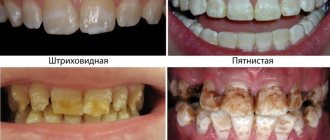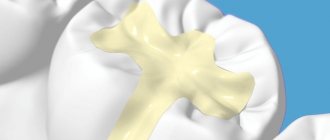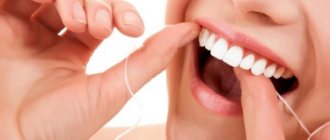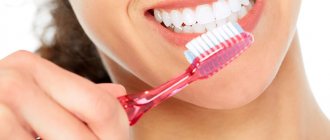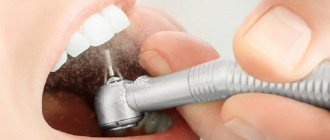Navigation:
- Causes of dental reaction
- How to relieve pain at home
- Consultation with a dentist
Common oral problems include painful reactions of units to temperature changes. This significantly reduces the quality of life, since the enamel is thinned and the degree of its fragility is significantly increased. This means that it does not protect against sensitivity and does not protect against the aggressive action of substances from the outside, that is, it does not work fully. And the thinner it is, the more strongly the dentin nerve fibers react to this. If your teeth hurt from cold and hot, most likely, hard tissues begin to break down.
Advice! ARTE-S dentistry professionally deals with such problems. We have the latest equipment and high-quality materials. We use advanced technologies.
In general, the disease develops in stages:
- At first, slight discomfort is felt when eating aggressive food. But the pain goes away quickly.
- Gradually, the unpleasant sensations after the irritants intensify, which forces the patient to consult a dentist.
- Then comes the most serious phase. Units react to any type of stimulus. The patient suffers from persistent acute pain.
When your teeth hurt from cold and hot, be sure to visit a doctor. Do this at the very beginning, when the organ is not completely destroyed. The dentist will immediately identify the reasons for this reaction and prescribe diagnostic examinations and procedures to strengthen the enamel. Also, recommendations will be given on the selection of specialized gels and pastes.
Separation of the concepts of “reaction” and “pain”
First of all, we should clearly separate the two concepts that we are accustomed to using to describe dental hypersensitivity - “reaction” and “pain”. They are very closely related to each other.
In fact, pain is the body’s reaction to various kinds of stimuli . This is a signal that allows a person to understand that there is a problem in the body, and the localization of pain indicates a specific area, the health and normal condition of which should be of concern.
That is, pain is always a reaction. At the same time, the reaction does not always manifest itself as pain.
The nature of the unpleasant sensations that arise in the teeth can be very different - from mild aching to sudden outbreaks of acute pain. A person, describing his feelings after drinking cold or hot, can use a variety of definitions.
Rationale for sensitivity
Modern clinical and scientific research has made it possible to identify the mechanisms of tooth sensitivity in different cases and situations. The results of these studies are used by both researchers and practicing dentists of most specializations.
This is due to the fact that pain is the leading characteristic symptom of most dental diseases, and its identification is very important for high-quality diagnosis .
At the moment, the temperature limits at which the tooth behaves normally, without giving any noticeable reaction, have been determined - from 10-12 to 55-65°C. This is a fairly wide range, resulting from the low thermal conductivity inherent in the hard tissues of teeth.
If an increase in their sensitivity is observed, despite the lack of innervation in these tissues, this is explained by two mechanisms:
- the first is a reflex reaction of the pulp, which has nerve structures;
- the second is the hydrodynamic processes occurring in hard tissues.
Prevention
To prevent the occurrence of unpleasant sensations, you should follow these recommendations:
- include foods rich in microelements and vitamins in your diet;
- refuse aggressive cleaning and enamel whitening agents - lemon juice, soda, and professional pastes;
- timely filling of teeth affected by caries;
- rinse your mouth with water after each meal containing acid;
- Avoid frequent consumption of citrus fruits and sweets;
- use a toothbrush with a suitable hardness level;
- do not chew hard foods and objects.
If your teeth hurt from hot temperatures, this may indicate dental problems. In some cases, the phenomenon is associated with diseases of the internal organs. To cope with the problem, you need to see a dentist and undergo the necessary examinations.
How to deal with the causes of changes in sensitivity?
To make a correct diagnosis and find out the causes of dental problems and diseases, it is very important not only to have a reaction to temperature stimuli, but also to the nature of the pain that occurs.
It varies depending on the specific clinical case and the individual characteristics of the patient’s body.
Damage to enamel
Enamel is the outer protective shell of the tooth and does not have nerve endings, therefore, in the absence of any problems, it cannot react to temperature stimuli.
Under the influence of various mechanical influences, chemical compounds, acids and much more, enamel can lose its original properties. In this case, the first thing that occurs is pain upon contact with cold .
Damage to enamel can be both local and global . For example, if chips and cracks appear on one tooth, then sensitivity to cold will manifest itself not only in it, but also in the neighboring – intact – teeth.
However, there are times when the enamel becomes thinner. There are many reasons for this: age-related or hereditary wear of the upper layer, incorrect bite, constant exposure to various aggressive factors.
If the pain goes away after a short time, long enough for the teeth to warm up, then there is most likely no serious problem.
Otherwise, when sharp pain upon contact with cold persists for a long time, we can assume the presence of a dental disease that requires prompt treatment.
Irritants for enamel damage can be cold drinks, ice cream, cold air inhaled through the mouth, very chilled food and other cold that comes into direct contact with the tooth surface.
This also includes a strong directed flow of cold air, with which the doctor blows or dries the surface.
Read how to restore tooth enamel using folk remedies in the next publication.
In this article we will talk about how Amazing White whitening differs.
At the link https://www.vash-dentist.ru/lechenie/zubyi/emal/giperesteziya-simptomyi-raznovidnosti-terapiya.html we will tell you what hyperesthesia of dental enamel is.
Dental exposure
The teeth are not completely covered with a protective layer of enamel. For example, it is not present below the gum line, since in a healthy state this area is hidden by soft tissue and reliably protected. The second layer and main hard tissue of the tooth, which makes up most of it, is dentin, which comes to the surface when the gingival margin changes.
The reaction of dentin to cold is very strong, and the pain can persist for quite a long time. At the same time, the sensations gradually become less intense, leaving a nagging feeling of discomfort. This is due to the presence of special tubules in the dentin, through which communication is carried out with the nerve center of the tooth - the pulp.
In this case, pain and various unpleasant sensations have their own name - dentinal sensitivity .
Treatment
If unpleasant sensations appear from time to time, depending on the intensity of exposure to cold and hot drinks, then in most cases it will be enough just to choose a suitable therapeutic and prophylactic toothpaste that reduces sensitivity.
Its action is based on the presence in the composition of substances necessary to strengthen the enamel by remineralizing it - filling it with minerals.
The same can be said if sensitivity goes away immediately after eliminating the irritating factor.
But if it’s not just an aching sensation, but a rather strong and sharp pain that reminds you of itself for a long time, then you should immediately consult a doctor , as this may be a sign of a more serious problem.
Traditional medicine offers many methods to combat dental hypersensitivity.
Let's briefly list some of them:
- drink warm milk, holding it in your mouth for a short time;
- rinse with salt solution (1 teaspoon per glass);
- Stir a few drops of tea tree oil in a glass of water and rinse 3 times a day;
- chew propolis;
- rinse with a decoction of burdock, chamomile, oak bark, and an aqueous solution of dried and powdered eggplant peel;
- Take eggshells, peeled and crushed to dust, as a dietary supplement - they are rich in calcium, which is necessary for enamel.
How is the treatment carried out?
Treatment for tooth sensitivity can be done in a dental office or at home. Before starting therapy, the cause of hyperesthesia must be determined.
Treatment in a clinic setting
If, after installing a filling, individual units or the entire jaw reacts sharply to high (low) temperature, you cannot do without the help of a doctor. When the cause of hyperesthesia has been identified, the doctor removes the old filling, excises the affected tissue, carries out antiseptic treatment, and then seals the canal again.
When grinding or abrasion of enamel, the specialist recommends the following procedures:
- Fluoridation of tooth enamel.
- Strengthening enamel with potassium salt preparations.
- Covering the tooth with a special filling material.
- Application of special applications.
- Correction of malocclusion.
If the cause of increased sensitivity is not identified, the dentist refers the patient to a therapist for additional examination.
Use of medications
If pain occurs after filling, then take a painkiller tablet: Ketanov, Ketorol, Nurofen or Solpadeine. To reduce sensitivity, it is recommended to use dental gels:
- Emofluor,
- Holisal,
- OCS,
- Fluoridex.
Desensitizing toothpastes will help to cope with hyperesthesia caused by poor quality of tooth enamel:
- Lakalut Sensitive,
- The president,
- Splat Biocalcium,
- Sensodyne,
- Aqua Oxygen.
Regular use of such pastes helps restore enamel and reduce sensitivity due to freezing of the nerve bundle. Pastes can be used not only for cleaning, but also for applying applications.
Folk remedies
To reduce pain after filling, you need to apply something cold to your cheek. When the pain has subsided a little, you can use folk remedies:
- Rinsing the mouth with a soda solution (1 tablespoon of soda per 250 ml of warm water).
- Rinse your mouth with oak bark infusion (1 spoon per 250 ml of water).
- Application based on tea tree oil and cloves.
- Application of sea buckthorn oil and propolis.
- Rinsing the mouth with chamomile infusion.
- Rinse your mouth with burdock tincture.
Another remedy for dental hyperesthesia is to drink warm milk during the day, holding it for a short time near the sore tooth.
Do you feel nervous before visiting the dentist?YesNo
When does the pain appear?
Many dental diseases cause pain, sometimes spontaneous, but more often caused by temperature stimuli. In most cases, the irritant can be either too low or too high the temperature of food or drinks.
Caries
The most common problem. When caries occurs, the hard tissues of the tooth are damaged - first the enamel, and then the dentin, which makes the tooth completely unprotected.
In the initial stages of this disease, pain is typical when exposed to cold. With deep caries, such a reaction will also occur to hot food, and quite strong.
It is necessary to visit a doctor to install a filling and thereby prevent further destruction.
Pulpitis
In fact, this disease is a complication of untreated caries, when the destruction reaches the internal part - the pulp, which is a fibrous loose tissue containing a nerve bundle and blood vessels.
If nerve endings are exposed, then the most striking reaction occurs to hot food . A sharp, very strong pain appears, which then subsides somewhat, but appears for a long time, as if pulsating.
Pulpitis requires immediate treatment, as it can lead to more serious problems - the occurrence of inflammatory processes that spread to soft tissues.
Wedge-shaped defects
This is also damage to the hard tissues of the tooth, but in this case it is not associated with caries. In the area of the neck, a small wedge-shaped defect appears at first. The more the disease progresses, the deeper the damage, and, accordingly, the stronger the pain.
Typically, this disease causes a reaction to cold..
If this problem is detected, it is advisable to undergo a course of enamel remineralization, and if the damage is deep enough, then filling will be necessary to restore the integrity of the tooth and prevent further destruction.
Here we have collected recommendations on what to do if a small piece of a tooth breaks off. What types of chips are there?
In this article, we provide average prices for Opalescence teeth whitening kits.
Read about enamel hypoplasia of primary teeth at https://www.vash-dentist.ru/detskaya-stomatologia/d-zubi/emal-dz/gipoplaziya.html. What consequences can the development of the disease lead to?
Periodontitis
Periodontitis refers to inflammatory diseases of the periodontium – the tissues surrounding the tooth. The gingival margin may change, exposing the cervical areas and neck of the tooth. The irritant in this case is cold coming into contact with dentin .
Treatment of periodontitis is long-term and requires careful adherence to the doctor’s prescriptions and recommendations. It also involves, first of all, professional teeth cleaning to remove various types of deposits.
How to relieve painful sensations?
If you have severe toothache, it is advisable not to take a horizontal position. First, apply a piece of ice to your cheek to reduce the intensity. Then you should rinse with warm decoctions of herbs - sage, chamomile, eucalyptus, yarrow.
You can also take painkillers - nimide, ibuprofen, ketanov, ketarol, nurofen, etc.
Types and degrees of hyperesthesia
Shapes:
- localized - only a few teeth are affected. Examination usually reveals either enamel damage or a wedge-shaped defect and other problems;
- generalized – sensitivity is observed in all or most teeth.
Hyperesthesia
Degrees:
- I degree – reaction to hot and cold;
- II degree – pain appears when eating salty and sour foods;
- III degree – sensitivity to mechanical, chemical and temperature influences.
I degree - tooth tissue reacts to a temperature stimulus
What manipulations can provoke?
Some dental procedures may cause temporary pain and sensitivity. At the same time, a ground tooth, with a pin, or a dead tooth under a crown may react to cold and hot.
Polishing and bleaching
Here the effect occurs directly on the enamel. Both procedures require preliminary thorough cleaning of tartar and soft plaque. In addition, polishing involves mechanical action using a special abrasive paste, and bleaching involves the use of hydrogen peroxide. All this for some time – several days – can cause increased sensitivity.
How to protect enamel when whitening, watch the video:
Sealing
Before performing the actual filling, the doctor drills out areas of tissue damaged by caries.
The pain that occurs in a treated and filled tooth without a nerve can last up to several days and intensifies when exposed to cold. This is a consequence of damage to the nerve endings during depulpation.
Crown installation
Installing a crown also involves some initial treatment of the tooth. In addition, the surrounding soft tissue may be slightly damaged.
Such an intervention does not go unnoticed and can cause minor pain, especially when exposed to temperature stimuli or mechanical pressure.
How to speed up healing?
It is considered normal to increase sensitivity and the appearance of a reaction to cold and heat during the first few days (from a week to two). In this case, the unpleasant sensations should gradually weaken over time until they stop altogether.
Preventive rinses should be carried out with warm solutions and decoctions, which will help speed up the healing process and relieve minor inflammation.
If, over time, the pain and reaction to heat or cold becomes brighter and more intense, this indicates complications that have many causes.
In this case, you must immediately visit your doctor, who, after conducting thorough research, will prescribe appropriate treatment and fix the problem.
If you find an error, please select a piece of text and press Ctrl+Enter.
Tags: toothache, hyperesthesia, treatment, tooth sensitivity
Did you like the article? stay tuned
Previous article
Deep bite: general information
Next article
Prosthetics of baby teeth: how is it done, why is it necessary?
Use of medications
Using special gels can significantly reduce tooth sensitivity. They relieve pain, contain substances necessary to strengthen the enamel and create a temporary protective film. They help in the first period after treatment, when the filled tooth is just beginning to react to cold and hot. In addition to eliminating the painful reaction to thermal changes, modern gels are good for preventing caries and periodontitis.
The most popular and common gels in pharmacies are:
- Emofluor is used for gum inflammation.
- OCS promotes enamel brightening.
- Fluoridex can be used on children by applying it to the teeth with a brush.
Desensitizing pastes have a good effect. It is better to choose them after consultation with a dentist, since you cannot constantly use medicinal paste. Such products contain fluoride, promote enamel remineralization and are low abrasive.
The following pastes are popular:
- Lacalut Sensitive with amino fluoride and sodium fluoride as active ingredients.
- Sensodyne, containing potassium chloride and eliminating the problem of open dentinal canals over time.
- Glister, which has good whitening properties.
- President, containing calcium hydroxyapatite, which strengthens bone tissue and solves the problem of open dentinal canals.
Stages of the problem
Over time, tooth sensitivity increases due to thinning of the enamel. It is this layer that protects teeth from external irritants: sour, sweet, bitter foods. As long as the enamel is thick, there is no discomfort during eating. When this layer thins, an acute reaction of the elements to possible types of food is noted, especially sweet, sour, cold and hot. Temperature irritants quickly penetrate dentin and affect nerve endings, causing acute pain.
Pathology goes through several stages in its development:
- The tooth feels cold and hot.
- Enamel reacts to salty, sour and sweet foods. Gradually the list of irritants expands.
- Elements react to any external stimuli, not just temperature ones. Inhaling air can cause severe pain. In advanced cases, unpleasant symptoms constantly plague a person, regardless of whether he eats or not. The situation leads to a decrease in the quality of life.
Under the top layer there is dentin, behind which sensitive nerve endings are hidden.
Pulpitis as a cause of pain after filling
With this pathology, inflammation of the nerves and blood vessels that are located in the dental tissue occurs.
Its occurrence can be provoked by nervous strain, infection and overheating of the pulp tissue.
Painful sensations after filling again indicate that the procedure was performed incorrectly.
Due to frequent night pain, the tooth is amputated, since the infection penetrates from the crown to the root area.
Another cause of pain is incomplete removal of the neurovascular bundle. There is a possibility that not all canals were found and passed through by the dentist.
The process of treating pulpitis most often extends over several visits to the doctor. In this case, the dentist will place a temporary filling from visit to visit until the treatment process is completed and the permanent filling is installed. If the treatment is delayed, after some time microscopic gaps appear between the temporary filling and the dental tissue, through which irritants (including cold ones) penetrate into the dental cavity, causing pain.
Possible reasons
Toothache under a filling can be both infectious and traumatic in nature, that is, it usually occurs either due to bacteria that cause inflammation entering sensitive soft tissues, or due to some mechanical impact.
In general, the tooth itself cannot hurt, since it consists of bone tissue, which, by definition, is not sensitive to pain. When pathogenic bacteria enter the pulp, it begins to become inflamed and cause severe pain. If you have already gone to the dentist once for treatment of a bad tooth, then repeated pain may occur for the following reasons:
- If the area damaged by caries is not thoroughly cleaned or a leaky filling is installed, a repeated carious process may develop, which, due to favorable conditions, will progress much faster. Usually, such mistakes do not happen when you contact a good specialist from a trusted clinic. So, if after treatment you are experiencing severe pain for a long time, especially if it is a filling on a front tooth, you should immediately make an appointment for a follow-up appointment. In advanced cases, the tooth will have to be removed. Fillings on the front teeth must be installed with special care and precision!
- Sometimes it happens that deep caries has already damaged the layer of dentin under the enamel, and the infection has spread further to the soft tissues, however, severe pain has not yet begun. The doctor removes the damaged area of enamel and fills the cavity. You return home, the anesthesia wears off and, perhaps immediately, or perhaps after a few days, you realize that your tooth hurts very badly under the filling. This means that the inflammatory process in the pulp has already reached the nerve endings, i.e. you have started to experience pulpitis.
- There is another situation. Let’s say a doctor has cured an advanced form of pulpitis, but the inflammatory process has already moved to a deeper level and has entered the periodontal area through the apical foramen in the root. Thus, if you have a toothache under a filling, and the nerve has been removed, there is a possibility of periodontitis.
- Another very unpleasant consequence of advanced forms of inflammation is a cyst. Most often, it grows for months, or even years, completely painlessly, while destroying the bone tissue of the jaw so much that it can no longer be restored without resorting to surgical intervention. So if your tooth hurts after a filling, do not put off going to the dentist, because this can result in very disastrous consequences.
- An allergic reaction to the components of a filling substance is not uncommon these days. Nowadays, new drugs are increasingly appearing that make it possible to reduce the patient’s treatment period to a minimum, but some of them contain potent components that can cause, among other things, irritation. If suddenly, one or two days after treatment, a tooth ache under the filling, perhaps the culprit is intolerance to some substance. Often this pain is accompanied by other symptoms that make it possible to diagnose an allergic reaction.
- Does a tooth under a filling react to cold, hot or pressure with aching pain? Possible reasons: shrinkage due to the use of low-quality material or left unfilled cavities, as well as the exit of filling material into the periodontium through the apical foramen. To avoid such a situation, it is recommended to contact only trusted dentists who have an X-ray machine at their disposal.
- No one is immune from mistakes, so even the best dentist can have trouble. Often it is necessary to clean the tooth canals from pulp residues with very thin instruments. If your tooth aches after filling, a possible cause may be a small piece of needle or drill tip remaining inside. An x-ray will allow you to rule out this possibility.
- And, of course, non-compliance with the doctor’s recommendations, as well as hygiene rules, can lead to painful sensations.
Diagnosis of pathology
At home, you can check the correct installation of the filling in a simple way - pour cold or hot water into your mouth.
If pain occurs immediately and passes just as quickly, the cleaning procedure for removing tissue affected by caries has not been carried out sufficiently.
Taking into account the fact that not all procedures were performed correctly in the treatment of pulpitis, the pain will gradually increase and just as slowly go away.
In some cases, pulsation appears inside the tooth - this is the result of overheating of the dental tissue during the preparation process.
If symptoms do not go away within a few days, consult a doctor.
Dentists diagnose the cause of pain by examining the oral cavity. The tightness of the seal is examined and exposure to cold air and water is applied. After removing the filling, the doctor performs probing by tapping on the tooth. When painful sensations appear in various areas, the existing pathology is determined.
Why do teeth hurt from sweets?
Content:
- Why do teeth hurt from sweets?
- Main reasons
- The most common symptoms of tooth pain from sweets
- How do sweets destroy enamel?
- conclusions
For many people, shopping for food is a weekly tradition, a centerpiece of a holiday gathering, or even a reward after a strenuous workout. Sweets, of course, are not ignored. Birthday cake, cupcakes, or just a candy bar (even if it's low in calories) can have a big impact on your teeth. This sensation can indicate several factors, one of which often leaves people wondering: Am I sensitive to sugar? Take a look at what sensitivity is and some of its symptoms.
Tooth sensitivity is a simple term for hypersensitivity of the root or dentin. Periodontal disease and diseased gums are the two main culprits: when the dentin at the root of a tooth becomes exposed, it loses its protective enamel coating. Unprotected dentin allows food, plaque and acids to penetrate and over-irritate the nerve deep within the tooth itself. This may cause pain. Sensitivity is also determined by other factors. If foods and drinks that are sweet, sour, hot or cold cause discomfort upon contact, then you may also be prone to this. Another symptom is the feeling of breathing in very cold air. This discomfort may come and go. Your enamel is likely damaged and is making you sensitive to sweets and other foods. Fortunately, for those who have a major problem with sugar-containing foods, there are solutions to help you enjoy your favorite foods and avoid discomfort.
While we often hear about sensitive teeth reacting to extreme food temperatures, there are other things that cause this unpleasant sensation. Many people suffer from painful teeth that are sensitive to sugary foods - regardless of the cause, this may indicate a consequence of enamel loss.
Why does increased tooth sensitivity occur after filling?
Tooth sensitivity after filling is a problem that often occurs in advanced stages of caries. If after a visit to the dentist the tooth under the filling hurts from the cold, this is a reason to seek advice again. This symptom may be a sign of pulpitis or increased tissue sensitivity (hyperesthesia). In some cases, this is a sign of improper treatment or violation of doctor’s recommendations.
In the article we will look at the reasons for such discomfort after tooth filling: pulpitis, hyperesthesia, erroneous actions of the doctor when treating caries, incorrect actions of the patient. Methods for diagnosing and solving the problem at home and at a dentist’s appointment are also provided.

